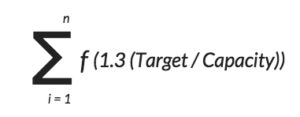In part one of this series, Divide & Conquer, Part 1: Breaking Down a Big Organizing Project, I elaborated a little bit on how to break down a big project into smaller chunks to make it more manageable. In this post and the next, we’ll tackle estimating time and involvement. I want to show you exactly how I calculate how long a project will take based on all the parts (or phases) you have broken it down into. It’s not exact science, but it works well for me, and I hope it can work for you too! Let’s get our math on!
“So… How Long Is This Going to Take?”
The biggest unknown variable of all when it comes to project management is obviously the question of “how long will it take?” This is what you’ll be thinking when you’re looking at all those boxes you have to organize, and if you have clients, this is what they’ll be thinking, trying to figure out how much it’s going to cost them. After all, time is money. It’s not a simple question to answer because everyone’s project looks different and since there is no one-size-fits-all solution, your only choice is to try and calculate it with as much accuracy as possible using the information you have available to you.
Calculating Your Project Duration
To figure out just how much time your project will take, you first have to figure out how long each phase of your project will take. If you followed the steps in part one of this blog series, you already have a list of different phases for your project. Following the example I gave in that article, the project looks something like this after the breakdown:
- Goal #1: Organize
- Phase #1 – 500 Slides
- Phase #2 – 300 Prints
- Phase #3 – 20 Home Movies
- Goal #2: Digitize
- Phase #4 – 500 Slides
- Phase #5 – 300 Prints
- Phase #6 – 20 Home Movies
You need to figure out how long each of these phases will take, and then add them up to find the answer for the entire project. The reason we treat each phase by itself is because 1) the different formats in this project need different machines that work at different speeds, and 2) it’s just that much easier to count. So what’s the sum of all parts? Keep reading, internet pal.
My Project Management Formula
Instead of guessing my way to the answers, I use a simple function to figure it all out. I call it my *magic formula.* Ok, so it’s not actually magic, and it’s far from advanced calculus, but it’s something I’ve come up with that works for me, and it’s much better than trying to guesstimate my projects.
It looks like this:
Duration for each phase ( Dᵪ ) = 1.3 * ( Target / Capacity )
The [D] stands for duration and the [ ᵪ ] represents each phase, and so for each phase, you multiply your buffer with the result of your target over capacity. This works no matter if you’re counting in hours, minutes, weeks, or months (just stick to the same one across your calculations and make sure to adjust your capacity accordingly, to represent per week, per month etc.).
If my now-retired math teacher had known that I’d be teaching functions, he would inevitably have fainted because I wasn’t exactly what you would call ‘the ideal student’ when it came to math. I loved linguistics, music, and art. It wasn’t until I started my business that I started appreciating functions for what they are – an easy way to make variables count. If he had only explained it like that…but I digress. Back to my *magic* formula.
What’s Your Target?
To make the formula work, you need to know your target for each phase. In the previous example, that would be the exact number of slides, prints, and home movies you need to organize and scan. In this particular case, we know exactly what we have: 500 slides, 300 prints, and 20 home movies, and we know what we want to do with them, but it not always as clear. If you have inherited a bunch of boxes, you may not know what’s in them, and if you have tens of thousands of photos, you may only want to scan a few thousand at a time. Your target is defined by you, and it’s based on how you have broken down your project.
Take Inventory, if Possible
Before you start your project, I recommend taking inventory to get an exact count of everything. If you can estimate the amount simply looking at your boxes, more power to you. I can’t do that. I take inventory every time – in detail. It takes time in itself, sure, but I feel more confident know that I get a very accurate estimated project duration and timeline out of it. I’ve spent anywhere from 2 hours to 20 hours+ on just taking inventory, but I’ve seen that I actually end up saving a lot of time in the end. That means I know what I need to bill in order to stay profitable. Kind of a big deal.
What’s Your Capacity?
To figure out your capacity, you have to look at least two factors: 1) how much time you need to complete tasks, and 2) if there are any limitations that can hamper your productivity. This overlaps with the topic of scheduling of your project (i.e. how much you can manage), but we’ll get into that more in part three of this blog series.
How Much Time Do You Need?
Some of us work faster than others, so it’s helpful to know exactly how much time you need in order to complete a task. To help me figure this part out, I track my time diligently every day using Toggl. I clock in when I start a task, and I clock out when I finish. If you haven’t tracked your time before, I would definitely tell you to give it a try. It’s a real eye-opener.
Many of us tend to underestimate how long things take us. I’m guilty of this too at times even though I try to keep track. We think in terms of best case scenario. Wishful thinking is all it really is. We say ‘gimme five minutes,’ and an hour later, we’re still not done. Without sounding pessimistic, we’re actually better off planning according to worst case scenario. At least then we might come away with time to spare.
Are There Any Other Limitations?
Apart from your own ability to be productive and keeping a reasonable work schedule, are there any other time limitations that prevents you from working faster than you normally could? A prime example would be the capacity of your equipment, if you’re scanning or doing any other type of automated work. You may have set aside 3 hours to scan, but your scanner has a limit on the number of scans it can do per minute. Therefore, your work speed will be limited to the time it takes to scan your photos, unless you have more than one machine running at the same time. Makes sense, right?
Do You Need to Invest in Better Equipment?
Pro scanning equipment comes in handy when calculating capacity. In business, it’s the key to your profitability and with personal projects, it’s the key to your sanity. If you have a regular slow flat-bed scanner, you may be able to get through one or two photos per minute. Scanning thousands of photos with a machine like that will become a long drawn-out process that requires a lot of patience. If you have a pro scanner, like the Kodak PS80, you will get closer to 85 photo scans per minute. Naturally, this can have a huge impact on your project, and whether or not you complete it. Once you’ve estimated your whole project, it’s worth looking into how you can improve your productivity overall, either by investing in different equipment, or by outsourcing.
1.3* = Your Buffer
So what’s the 1.3 in the formula? Well, that’s your buffer. With every phase of the project, I like to add about 30% more to my time estimate because things don’t always go as expected. Machines jam and break sometimes, and you’ll definitely get interrupted every now and then. Once something like that happens, it takes a while to get back into the groove. I’ve found 30% to be my magic number because I tend to get interrupted a lot (something I’m working on, I promise!), but you may find that your number is higher or lower. I started with 30% a long time ago, and I’ve stuck with it because I’d rather come in ahead of time than trying to catch up after the fact. Your number may be anything from 10-30% or more, and you’ll only find out with some experience.
If you have a different number, adjust the formula accordingly. Is your estimate 10%? Use 1.1 instead of 1.3. If it’s 20%, use 1.2. More like 40%? Use 1.4 in the formula. More than 50% – do yourself a favor and outsource the whole project, or hire a coach to help you become more productive.

I’m a Perfect Pinnable!
Wanna Test Your Guesstimating Skills?
Before we get into the actual calculations, I want to challenge you to test your guesstimating skills.
The example project I’ve given includes 500 slides, 300 printed photos, and 20 home movies. Everything is in great condition and needs no further work. We have a fast slide scanner that does 1 slide every minute, but a slow photo scanner that can only handle 4 prints per minute. The VHS converter for the home movies runs at true speed and each tape is 2 hours long.
Without using the formula, how long do you think it would take you to complete this project (in hours)? In other words, how long do you think it would take you to first organize these memories and then scan them? Write down your best guess and then read the rest of this article to see if you were on point. Averages are fine.
Note: This is obviously a hypothetical scenario with made up machines, just to show the calculations. I have estimated some of the capacities according to my workflow, which I feel is a decent speed, but just know that your numbers may look very different in real life.
Estimating the Time for Each Phase
Alright, now that you understand all the parts of the formula, let’s get to the calculations!
Remember, the formula is:
Duration for each phase ( Dᵪ ) = 1.3 * ( Target / Capacity )
To start, we use the formula for each phase of your project:
- Phase #1: Organize 500 Slides
- Target: 500
- Capacity: 50/hour
If we plug the numbers into the formula, it looks like this: D1 = 1.3* (500/50). 500 over 50 is 10, and times 1.3, it comes to 13. Phase #1 will take 13 hours in total at this working speed.
Let’s continue the same way with the rest of the phases in this project.
- Phase #2: Organize 300 Prints
- Target: 300
- Capacity: 50/hour
If we plug the numbers into the formula, it looks like this: D2 = 1.3* (300/50). 300 over 50 is 6, and times 1.3, it comes to 7.8. Phase #2 will take a grand total of 7.8 hours. Rounded up, that’s about 8 hours.
- Phase #3: Organize 20 Home Movies
- Target: 20
- Capacity: 10/hour
Using the formula, it looks like this: D3 = 1.3* (20/10). 20 over 10 is 2, and times 1.3, it comes to 2.6. Phase #3 will take just under 3 hours. I like to round up, so I’ll say 3 hours flat.
- Phase #4: Digitize 500 Slides
- Target: 500
- Capacity: 60/hour (Machine can scan 1 slide every minute)
In this phase, we’re dealing with a machine that limits our speed to one slide per minute. Here’s what this looks like: D4 = 1.3* (500/60). 500 over 60 is 8.3, and times 1.3, it comes to 10.83. I’ll say 11 hours.
- Phase #5: Digitize 300 Prints
- Target: 300
- Capacity: 240 / hour (Machine can scan 4 prints every minute)
In this phase, the scanner can finish 4 prints per minute, so our capacity is once again limited to this. Let’s plug in the numbers: D5 = 1.3* (300/240). 300 over 240 is 1.25 and times 1.3, it comes to 1.625. That just over 1.5 hours. Let’s call it 2 to round up. Better safe than sorry.
- Phase #6: Digitize 20 Home Movies
- Target: 20
- Capacity: 1 per 2 hours (Machine converts at true speed; running time for each tape is T-120 min).
For the final phase, our machine is once again limiting the progress to the actual running time of the tapes, which makes it take a little longer as each tape is 2 hours long. If we use the formula, it looks like this: D6 = 1.3* (20/0.5). 20 over one half (or 0.5) is 40, and times 1.3, it comes to 52 hours in total for the final phase.
What’s the Total Number of Hours?
To put all of this together, and get the answer to the question “how long will it take?,” we add up the total number of hours for all the phases. Doing this for our example project, we can see that it will take a grand total of 89 hours (13+8+3+11+2+52) to finish the project, or almost 45 weeks if you were to set aside 2 hours a week to work on it.
Now tell me, were you right in your guesstimate?
All you math aficionados out there may want to think about the process more as a whole, like this:

Do I always round up? Yes, but just to make it easier to count. If you’re good at math, you can go with the exact numbers because you already have the 30% cushion built-in. I tend to waste a few minutes here and there, so I don’t go into that much detail. Rounding up works well for me, but like I mentioned before, it’s not an exact science. 🙂
To Outsource or Not to Outsource
A big part of project management is knowing when and when not to outsource, and that’s something that I continually strive to get better at myself. By breaking down the organizing project like this, you get a clearer understanding of where the real time-suckers are because you can look at each part of the project individually. If your slide scanner is really slow, maybe you can outsource that part of the project? How much can you reasonably manage given your current situation?
In this hypothetical project, you can clearly see that much of the time goes to the video conversion, which runs at true speed because of the equipment that’s used. If you were to outsource that part of the organizing project, it would cut your time estimate by more than half the hours! That’s 52 hours saved. Is the cost of outsourcing worth your time? I’d say YES, but you be the judge.
Any Big Organizing Project Will Take Time
Getting good at estimating time takes practice, but eventually you’ll get good at running this function in your head. The fact is that most projects take a lot longer than you think they will, so if you’re clear on this up front, you’ll be much better at taking inventory and setting aside enough time to complete the project.
Stay tuned for the next blog post where I’ll show you how to actually schedule your new project into your calendar, so it’ll actually get done!
What say you, readers? How do estimate your projects? Were you right in your guesstimate? Satisfy my curiosity by commenting below!
PS! Here’s a Pro tip for ya: To give you an idea of how long your inventory phase will take, just use the formula again. 🙂
Ready to move on to the last parts of this series? Click here for Divide & Conquer, Part 3: Scheduling Your Big Organizing Project!





